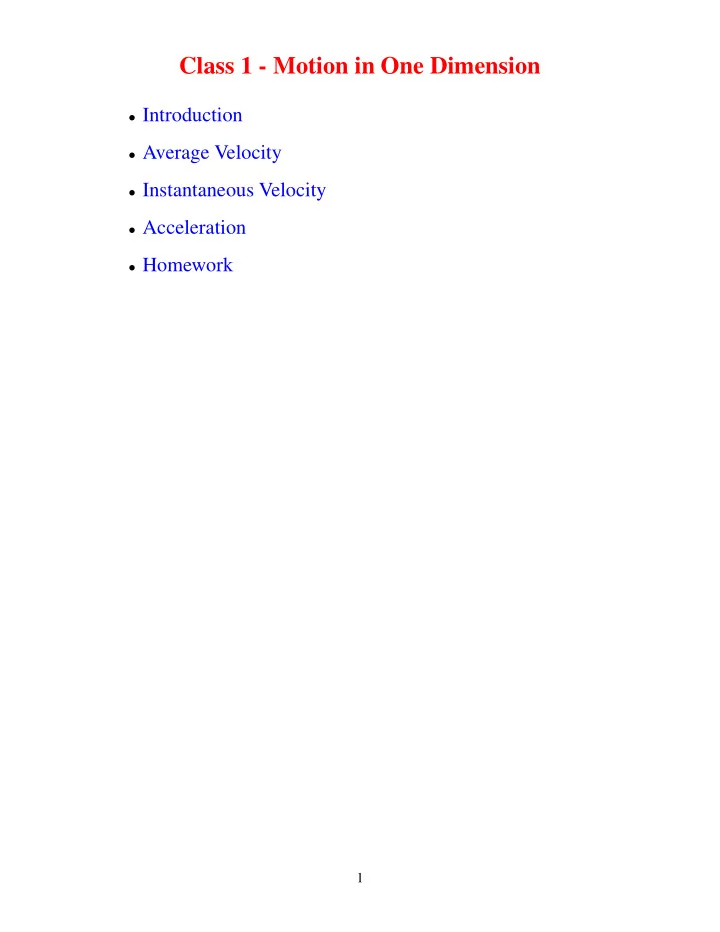

Class 1 - Motion in One Dimension • Introduction • Average Velocity • Instantaneous Velocity • Acceleration • Homework 1
Average Velocity Consider the motion of the car shown in the figure below. 2
Average Velocity (cont’d) The graph of this motion is shown below. The average velocity is defined as the distance traveled divided by elapsed time v x = ∆ x ∆ t = x f − x i t f − t i where ∆ x = x f − x i is called the displacement. The average velocity is the slope of the line joining the initial and final points on the position-time graph. 3
Example 1: Calculating Average Velocity From the position versus time graph for the motion of the car, estimate the average velocity of the car between (a) points A and B and (b) points C and E. 4
Example 1 Solution From the position versus time graph for the motion of the car, estimate the average velocity of the car between (a) points A and B and (b) points C and E. x f − x i (a) v x = ∆ x t f − t i = 55 m − 30 m ∆ t = = 2 . 5 m/s 10 s − 0 x f − x i (b) v x = ∆ x t f − t i = − 37 m − 37 m ∆ t = = − 3 . 7 m/s 40 s − 20 s 5
Example 2 You drive your BMW down a straight road for 5.2 km at 43 km/h, at which point you run out of gas. You walk 1.2 km farther, to the nearest gas station, in 27 min. (a) Calculate your total displacement. (b) Calculate the total elapsed time. (c) What is your average velocity from the time you started your car to the time you arrived at the gas station? 6
Example 2 Solution You drive your BMW down a straight road for 5.2 km at 43 km/h, at which point you run out of gas. You walk 1.2 km farther, to the nearest gas station, in 27 min. (a) Calculate your total displacement. (b) Calculate the total elapsed time. (c) What is your average velocity from the time you started your car to the time you arrived at the gas station? (a) ∆ x = 5 . 2 km + 1 . 2 km = 6 . 4 km 5 . 2 km (b) ∆ t = 43 km/h + 27 min = 0 . 12 h + 0 . 45 h = 0 . 57 h (c) v x = ∆ x ∆ t = 6 . 4 km 0 . 57 h = 11 km/h 7
Instantaneous Velocity The instantaneous velocity is the velocity at a particular instant in time. ∆ x ∆ t = dx v x = lim dt ∆ t → 0 8
Graphical Representation of Instantaneous Velocity The instantaneous velocity at a particular instant in time is the slope of the position versus time graph at that instant. 9
Example 3 Estimate the instantaneous velocity of the car at point D in the position versus time graph below. 10
Example 3 Solution Estimate the instantaneous velocity of the car at point D in the position versus time graph below. v x = ∆ x ∆ t = − 40 m − 40 m = − 4 . 0 m/s 40 s − 20 s 11
Example 4 The position of a particle moving along the x-axis is given by x ( t ) = 7 . 8 + 9 . 2 t − 2 . 1 t 3 with x in meters and t in seconds. What is the velocity of the particle at t = 3.5 s? 12
Example 4 Solution The position of a particle moving along the x-axis is given by x ( t ) = 7 . 8 + 9 . 2 t − 2 . 1 t 3 with x in meters and t in seconds. What is the velocity of the particle at t = 3.5 s? v x ( t ) = dx ( t ) = 9 . 2 − 6 . 3 t 2 dt v x ( t = 3 . 5 s ) = 9 . 2 − 6 . 3(3 . 5) 2 = − 68 m/s 13
Acceleration • Average acceleration a x = ∆ v x ∆ t = v xf − v xi t f − t i • Instantaneous acceleration ∆ v x ∆ t = dv x a x = lim dt ∆ t → 0 14
Example 5 (a) Your car, starting from rest, gets up to 55 km/h in 3.2 s. What is its average acceleration? (b) Later, you brake your car to rest from 55 km/h in 4.7 s. What is its average acceleration in this case? 15
Example 5 Solution (a) Your car, starting from rest, gets up to 55 km/h in 3.2 s. What is its average acceleration? a x = ∆ v x ∆ t = 55 km/h − 0 = 17 km/h · s 3 . 2 s 1000 m 1 h = 4 . 7 m/s 2 a x = 17 km/h · s 1 km 3600 s (b) Later, you brake your car to rest from 55 km/h in 4.7 s. What is its average acceleration in this case? a x = ∆ v x ∆ t = 0 − 55 km/h = − 12 km/h · s = − 3 . 3 m/s 2 4 . 7 s 16
Homework Set 1: Due Fri. Sept. 9 • Read Sections 2.1-2.5 • Answer Questions 3 & 4 • Do Problems 1, 4, 9, 13 & 14 17
Recommend
More recommend